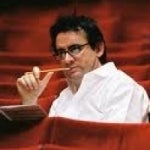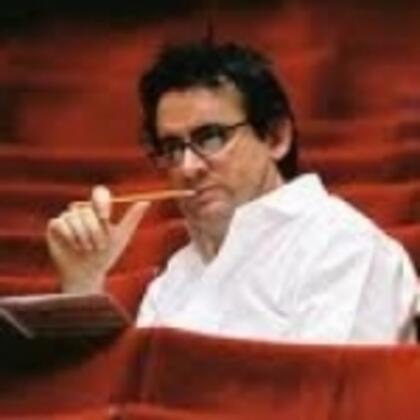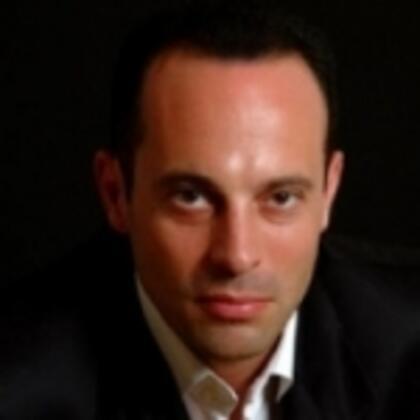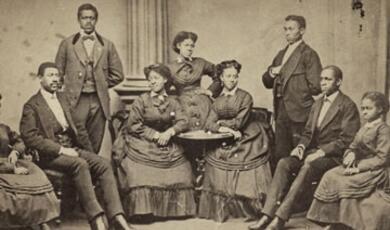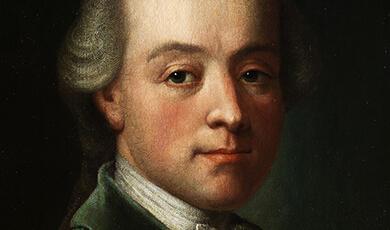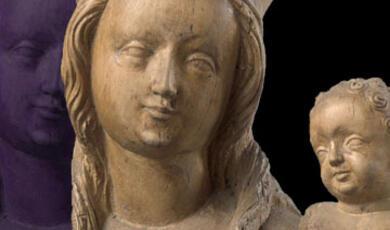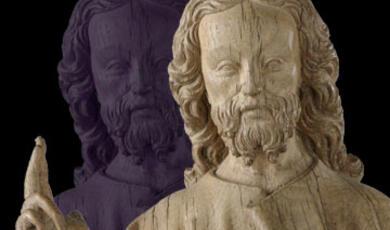21 February 2013
Darkness Audible: Benjamin Britten at 100 –
Late, 1971 - 1976
Dr Paul Kildea
There is a wonderful contradiction between the Britten of the early-1970s and the Britten of the late-1960s. There is an excitement. Here he is at Snape, at the concert hall at Snape. There is a real excitement in this new venture that he has undertaken, notwithstanding that the concert hall burnt down at the opening of the 1969 festival. They had it open again in time for the 1970 festival.
Here you have some of the kids of the Wandsworth Choir, who were singing the Children’s Crusade. The Children’s Crusade is an incredibly bleak and dystopic picture to a Brecht poem, and it is this idea of these children who are, by this stage, orphaned in the War and there are no adults left. This is the community of children, and that they go off searching for hope, and they capture a dog at one stage, and in the course of this poem, they almost become the adults and enact adult rituals. For instance, a child dies, and so they bury him as best they can. There are the fights between the varying camps within this sort of community of children. There is the determination that one would end up a leader, and there is another one that wants to be, and then, ultimately, you are left with this picture of just a single dog, the dog with a little note round its neck, wandering, saying, “We are lost – we are the band of children and we are lost,” and so, presumably, by then, all the children have died and the only survivor is this mangy, very thin dog.
Britten, of course, was intrigued by this idea of childhood being taken away from children before time, and, on a tour to Australia in 1970, in the spring, where he toured around what was then called Ayers Rock, but now known as Uluru, the indigenous name, with the painter Sidney Nolan and his wife Cynthia. I once asked Nolan’s biographer, Tom Rosenthal, about the couple, and he said that if Britten could display extraordinary good feelings towards Cynthia Nolan, he was a man of great tact and talent, because he said she was a complete monster. I do not know – that is the biographer speaking, and you must never trust them!
Nolan, in this period, decided to do his own artistic depictions of the Children’s Crusade, and they are amazingly bleak and black, and rather touching pictures as well, the last one being the one of the dog with the little note saying the dog knows its way.
Britten, on this trip, talks about possible artistic ideas and what he wants to do with the festival, and confesses to Nolan that he thinks that he will just die in the harness and that that is what he is, and this whole idea of being in Australia and in the Australian Outback, which he found idyllic, was to him an impossible land and that he was to come back and run his festival.
The interesting thing also about the two Brittens is that it was being picked up by critics at the time, and not just in the way he looked, but in the music he was writing. You have people starting to say those of you that were scared about the increasingly bleak music that Britten is writing in the 1960s, you can be rest assured in 1966, with this new cycle, he has some of his old style and spirit back.
What you also see at Snape Maltings, in footage in 1970, when they reopen it, after just a year after it had burned down, you see a very, very ill Benjamin Britten, and this is to my mind, the two Brittens is the difference between illness and good health, and it seems to happen in a very short space of time. If you look at photographs up until about 1968, he looks exactly as he has always looked, this very healthy young man, and in 1970, conducting scenes from “Gloriana” in the reopening of the Snape Maltings, he has become incredibly bloated, his hair is now completely grey, he sweats, he is staring into his score of his own music as he conducts it, and looks exhausted by what he has been just conducting, which is the final scene of “Gloriana”, a very poignant return to a work that had continued to haunt him since its failure in 1953.
This is the ‘well’ Britten, but even at this stage, you can see him filling out, becoming a rather different creature from the very thin and spindly person he was in the 1960s.
A very rare photo of him and Pears playing duets, something they tended to do only as an escape, the thing that they liked to do for their own entertainment and their own domestic situation, here, obviously, in probably a fundraiser, I would say, for yet more money needed for the Maltings.
What happens also in 1970 is he writes this piece which I call a pivotal piece in the transition, between the two Brittens, on the one hand, the Britten writing this rather austere music in the 1960s, a well man, to a Britten writing rather vibrant, incredible music in the 1870s, a very sick man. The piece that does that transition is the opera “Owen Wingrave”, which he writes for television, and it is commissioned by the BBC. He chooses the subject because he feels as though, after this decade of rather austere works, and also his withdrawal into the community at Aldeburgh, and to the new concert hall at Snape, he wants to write something that he thinks will have an enormous impact and of course on a subject that is very close to his heart, and that is the idea of pacifism.
The story of “Owen Wingrave”, as many of you would know, which is another Henry James novella, much along the lines of “The Turn of the Screw”, is about a young man at a military academy, from a very large and prestigious military family, who decides, at about the age of 18, that he does not want to be part of the war machine, and then has to go home and tell his fiancée, his fiancée’s mother, and his grandfather, of his decision. Of course, the grandfather, played by Pears, disinherits the boy, and the mother of his fiancée, who is a pretty frightful character, as is the fiancée, when it comes down to it, they both goad him about his decision. The fiancée goads him because she says it is a symbol of cowardice and, whereas, of course, it is actually anything but to come and face up to a family like this and tell them of this decision. So, she goads him into staying the night in the haunted room in the house, and we only find out that the haunted room is haunted, or in fable is haunted, because a generation, or three generations ago, a father had hit his son and hit him so hard that he had killed him, and so this is this monstrous family that Owen’s trying to get out of really. Of course, what happens is, to appease his fiancée, he sleeps the night in the room, but then, she has a change of heart, and in the middle of the night, goes down, opens the door, and he is dead, and a bit like “The Turn of the Screw”, as you remember, there is no real explanation for why he died, and all you have is the family then rehearsing their grief for their own actions, for Owen’s decisions, and that is how the opera ends.
It is an unsatisfactory ending. It builds and builds and builds, a bit like that in “Turn of the Screw” but then it just fizzles and it does not have the impact of “Turn of the Screw”. But that should not take away from the fact that it is a really extraordinary score, and he has – some of the things that he had been experimenting with in the mid-‘50s, so the ideas of gamelan music and the really, really careful writing for percussion. It seems to jump back and miss all the austere music of the 1960s and tap into a far more opulent sense of what music and opera was that Britten displayed in the mid-‘40s to the early-‘50s, if you like, before the “Gloriana” debacle made him withdraw more and more into himself. So, it is an unfairly neglected work, that is for certain, and it suffered also from not very good production. The first filmed production was very cramped, and then when it went to Covent Garden, it was not much better. It is one of those stillbirth operas, and I am optimistic that it will eventually take its place in the canon, or at least on the outsides of the canon.
The reason we are not performing any music from it is that the major work, or the major arias and the major part, is for baritone, and that the writing for Peter Pears’ character, the grandfather, is really ungrateful writing. Colin Matthews, Britten’s assistant at this time, thought that he was almost parodying some of Pears’ vocal mannerisms in writing for this character, and for me, that seems a little unnecessarily cruel, but it is certainly possible.
What it does is, straightaway, after the church parables and the pared down palette of the 1960s, you have Britten engaging with grand opera once more, even if it is on a slightly smaller scale than “Billy Budd” or “Peter Grimes”.
Straightaway, he decides that there is one more thing he wants to write, one more role for Pears, an incredibly grateful one, after the ungrateful writing in “Owen Wingrave”. He wants to write for himself because he has this feeling now that he is incredibly unwell, and his doctor, at this stage, in around 1971, says, okay, we want you to go and see a heart specialist, and Britten says, no, no, I have this one idea for an opera, and it is an opera based on a piece, a story that he had been thinking about for a long time, which is Thomas Mann’s “Death in Venice”.
Now, everyone in the Aldeburgh circle, when they heard this, just went, oh no…please…please do not tackle this story! For those of you that do not know it, of course, it is the story of an aging writer, but actually, in the Mann, he is only about 46, who feels that he has run out of inspiration, and instead of going to the mountains, as he normally does in the summer, he goes to Venice. In Venice, where he thinks he will find his inspiration, he there falls in love, or infatuation, with a teenage boy, and then becomes completely obsessed by him and feels as though he is the key not just to an emotional enlightenment, if you like – he had been previously married and now widowed – but also that this boy is somehow the key to his continued creativity or re-sparked creativity. Then, when he reads about warnings in the paper about a cholera epidemic, and they are denied by the hotel people, etc., he decides to leave, but then decides to come back and stay there and pursue this boy even further, and then finally, at the end of the opera, you have him being beckoned to by Tadzio, this beautiful boy, and he gets to stand in his deckchair at the sea because he feels as though this is now finally the signal that the boy wants him, but he then slumps dead in his chair, dead of cholera, and you realise then at that moment that the boy is probably Hermes, the god, taking him from one world to the next.
It is a desperately sad story, but it skated very close to some of the infatuations in Britten’s own life, and that is why people thought it was a very dangerous opera for him to write. It, like “Owen Wingrave”, is full of really vibrant and brilliant music, and even though you have Peter Pears at this stage saying to Sidney Nolan, “Ben’s writing this terrible opera and it is killing him!” and even though you have this threat of surgery hanging over Britten and this sense of illness and just this desperation and tiredness, this inability to walk up stairs without having to stop halfway up the landing, the inability to play tennis anymore. All of these things that he had done so easily and fluently as a young man, all of this is hanging over him, but still, he writes this music of great vitality, and it deals very sensitively, but skating very close to the edge of some of these obsessions that Britten had had all his life, namely whether it is possible to have platonic love of a young pre-adolescent boy, whether creativity is tied up with the notion of love, whether order or chaos should actually govern a composer or an artist in his or her life, whether Dionysian urges should give way to Apollonian order, and this is something that Britten had been thinking about for a very long time. It comes across in one of the most famous arias, a very still aria, towards the end of the opera, where Aschenbach recreates the conversation between Socrates and Phaedrus, which we will perform for you now.
[Music]
It is so much the Auden and Britten of 1941. Remember the letter that Auden wrote to Britten in 1942, just before he goes back to England from America: “Goodness and beauty are the results of a perfect balance between order and chaos, bohemianism and bourgeois convention. Bohemian chaos alone ends in a mad jumble of beautiful scraps; bourgeois convention alone ends in large unfeeling corpses. Your attraction to thin as a board juveniles, i.e. to the senseless and innocent, is a symptom of this, and I am certain too that it is your denial and evasion of the demands of disorder that is responsible for your attacks of ill-health – i.e. sickness is your substitute for the bohemian.” It is an amazing idea that this was planted into Britten’s head in 1942 and then just percolates there for over 30 years, and then comes out so emphatically in this piece.
You see it even in the urgency of his sketching. This is on a trip to Venice, where he comes up with this so-called Serenissima theme, and Serenissima is the historical name, or a historical name, for Venice, and where he sketches in this book madly, goes around the streets of Venice, finds gondoliers who will give their calls to him, and he notates them down, listens to the bells clanging around, and he is so obsessed with this idea and brings it across into the breathless urgency of the piece. If you look at the opening of his manuscript to it, Aschenbach is walking through the streets of Munich on a spring evening, but it has this incredibly repetitive ostinato that is almost his heartbeat at the same time as it is his restlessness.
You have something very contemporary about it, but you also have something very 1940s about it, but you also have something very contemporary, and the 1940s-ness is suggested in it.
He also returned to the idea of Mahler in this piece, perhaps more than he had before. Do not forget, at this stage, the film “Death in Venice” was being made by Visconti. Now, Britten was advised by his lawyers not to watch it so that there was no sense that he had borrowed from it, but of course, the figure in there, or the tragic figure in that is Mahler, and certainly Mahler’s music is used to such a great extent. But it is really amazing as well that, even though Britten chose not to see the Visconti, there are such strong threads of Mahler in his own writing, not least of all the moment after Aschenbach dies, and it is at this moment that the orchestra plays which lasts about 90 seconds, and it combines this Mahlerian spirit that Britten has with the sound world that is attached to the boy, the beautiful boy Tadzio. It is some of the most beautiful and touching music that Britten wrote in his entire career.
[Music]
The 1940s aspect of it is underlined. This is the first stage production at Snape. I was at a concert just the other day and sitting next to someone who said, “Oh, my name is Stephen Terry.” I said, “No way!” Stephen Terry was the first Puck in “A Midsummer Night’s Dream” and it was rather like running into this rather wonderful dancer at the time.
The connection, I find, at this stage, is really jumping over the 1960s, jumping back into the music of the very early-1950s and also the 1940s. For those of you that wondered why I would have left out one of Britten’s most famous pieces in the first lecture, it is because I feel as though it works as a real counterpoint here to the music of the 1970s, this final period of his, where he was reinventing himself with great vitality after a fairly dour decade, it had to be said. So, here it is, in its triadic, its use of triads, which fascinated him as a boy, and, as you could hear in that little Phaedrus monologue, was fascinating him again as an older man. Here it is, the use of the triad, in all its beauty, in the Keats’ sonnet, from the “Serenade for Tenor, Horn and Strings”.
[Music]
You can see The Queen Mother, quite a close friend of Britten’s, responding to the extraordinarily slow recovery that Britten experienced from the heart operation in 1973. It was thought that he would make a complete recovery, and certainly, when he went into surgery, he had been told by his heart specialist, Graham Hayward, that he would make a recovery and that he would be back conducting, and all the things that he had found incredibly difficult in the last years of his life, before the operation.
In November 1974, he is with his really wonderful and supportive nurse, Rita Thomson, and turns to her and says, “I am not going to get better, am I?” and she says, “No, no, you are not,” and this is a year and a half after surgery. She says, “Some people will tire you out, some people will love you, some people will make you feel better, some people will make you feel worse,” and it was at that moment that Britten decided, well, I really am running very short of time and I am going to use this time as best I can.
Now, he does that in a number of ways. He cannot reach up to the top of large manuscript paper anymore, so he has to work very closely with his assistants, whether they be Rosamund Strode or Colin Matthews. He cannot shave in the morning. He needs help getting dressed. He does not come down really from bed until about eleven in the morning. Slowly, he tries to get back into a semblance of his pre-operation self, and a semblance of his composing self, this artist that he had been for 50 years or more, and so he revisits some old works.
His publisher at this stage, Donald Mitchell, had been instrumental in fishing out some of the old works that he had confined to his desk of horrors or, you know, trunk of horrors, and looked at them. Now, there are two things at play here. The first is this idea, the music that this young man had written and then discarded, had come so effortlessly to him, and he was so cross with himself and so pleased with himself, simultaneously, that what was so effortless then was now such a monumental struggle. But he did, he looked at some of these early string quartets and he looked at some of the early songs and started sort of saying, well, actually, I was rather clever at that stage, and he revisits the idea of folk songs. He can no longer play the piano because of the heart operation and the stroke he suffers, and so he starts writing evermore for Pears as an ensemble with the harpist Osian Ellis, and the thinking there is, if he cannot play the piano, there is damn no chance that he is going to give it to someone else to play the piano, so he writes for harp instead.
People do rally around him as he tries to cope with this sickness and infirmity, and not least of all the Queen Mother. Here she is as patron – they ask her to be patron of the Aldeburgh Festival – and Britten looking rather good. This is in 1975, welcoming her to lunch at the Red House, and Pears looking like the grand patrician that he was. This is healthy Britten and looking good on it. She had commissioned him, as a way of helping him to start writing original music again, and so this is one of the pieces that he wrote for Osian Ellis and for Peter Pears, and it was to celebrate her birthday. It sounds very much like a folk melody, and folk music was occupying him a little more in this period, as a way of helping him to get back into the art of composing, these are original works, and this is one of a cycle, called “The Winter”.
[Music]
One of the works he was completely hesitant about revisiting, but gradually, in the 1970s, as his health worsened, and then ultimately when the poet himself died, he revisited “Paul Bunyan”, the operetta that he had written with Auden in 1941. It was something that he almost could not go back to while Auden was alive – the memories of the collaboration and the memories of the breakdown in their friendship weighed incredibly heavily on him, and when he heard about Auden’s death in ’73, he broke down crying straightaway and worried about how he could be so stubborn and throw away such a valued relationship. So, he decided to fish out, at Peter Pears’ encouragement, “Paul Bunyan”, and they did little excerpts, very informally, and then did something a little more extensive, then they broadcast little bits of it, and each time, Britten tinkered with it, and then, finally, they decided to mount a complete performance of it in 1975. Britten was overwhelmed by this, by the vitality of the music, by the memories he had of this great friend of his who had died, and you can tell, I mean, we did the Inkslinger aria, but we will just recapitulate a tiny little bit of it to give you an idea of what it was that so encouraged him in the context of the death of this very great man who hectored him and who had helped turn him into the artist that he was.
[Music]
Emboldened by such rehabilitations and by his engagement with poetry, he hears Janet Baker singing some Berlioz and decides to write a cantata for her. He writes it in an extremely short space of time: he hears her in 1975, in the June, immediately sits down, selects the poetry, in translation, by Lowell, and it is Racine’s “Phedre”, and sets it in the space of a matter of a month, and then, in 1976, invites her to the Festival to give the first performance.
So, you have Colin Matthews in the background there, in a photograph he would probably prefer I did not display, Janet Baker of course, Britten, this incredible concentration, and this is again the two Brittens: you would have him this really fierce, concentrated mind, or you would have this slightly enfeebled, droopy man – and then Rita Thomson, his nurse, just there, which I like to think of as his guardian angel.
She gives this performance of this incredible piece that is about Phaedra, who falls in love with her step-son, and then tries to pretend, when he rejects her, that it was all his idea, and so the father of the step-son, Phaedra’s husband, orders his death. Now, you miss a lot of this in the contraction, but, again, it is an incredibly skilful contraction and reminds me very much of the contraction that Pears and Britten did on Shakespeare’s “A Midsummer Night’s Dream”, and you get this monologue which finishes with Janet Baker standing there, or Phaedra standing there, saying, “I absolve your son – he did not actually do it, it was all me, and I have taken poison – Medea’s poison darts through my veins…” and then the music just sort of winds to a halt, as the heartbeat of Phaedra sort of gives way to nothing. It is incredibly powerful music, and again a piece that I like to think of as testimony to this period of vitality in Britten’s music.
I think, because he was so ill, something we will get onto next, a lot of people have said over the years that this music was very weak as well. Now, it is true, in the 1960s, the late-1960s, there was a feebleness to it, to some of the music. Colin Matthews says, for instance, that it must have been evident, to Britten even himself, in the late-1960s, that he was going over a lot of old ground and that he was not actually embarking on really new stuff. But what happens then is people do not recognise that this music of the 1970s, this period of five years, including this extraordinary cantata, is music of great vitality. It is caught up in the narrative of decline involving Britten’s own health, and people feel as though, because he is so unwell, the music itself is lacking in strength, and that is not the case.
The final piece that Britten was working on, again with his great sense of urgency, the time was short, was a string quartet, his first string quartet since 1945, and here we are in November 1975, 30 years later, in Venice, where he goes for the last time. He comes up with all sorts of reasons why he cannont go – he does not feel well enough, the flying is too difficult, what will he be able to do, he is confined to a wheelchair. But Rita Thomson, who is probably behind him there, overcame all of his objections, or each of his objections, and finally they go, in November, to Venice, for the final time, a city that has had such a large and strong impact on him all his life, and it is here he makes lots more sketching for the string quartet, for the “Amadeus Quartet”.
This itself is a work of hypnotic beauty and great vibrancy. It leapfrogs as well the 1960s, these austere, pared-down works, to the much more opulent string writing of the 1940s, his previous numbered string quartet.
This is June 1976, he is made Lord Britten of Aldeburgh, the Borough of Aldeburgh, and this is the small Garden Party, but he is still working on this sketch of this string quartet for the “Amadeus Quartet”.
It is June. Due to the stance he took on Solzhenitsyn, Mstislav Rostropovich had been not allowed to travel, so he had missed Britten’s decline in health, and here is their first reunion after the ban on his travel had been lifted. He is greeting Galina Vishnevskaya, with Rostropovich looking on, and an incredibly moved Peter Pears watching this reunion, and Rostropovich later saying he could not believe how frail this man was and in such a short space of time. A lot of people at the premiere of “Phaedra” said the same thing: how could this man standing in the box, gingerly and totteringly, taking applause for this vibrant and visceral cantata, how could they be the same people, the composer and this man there? You read all this on everyone’s faces there, the sadness of this life drawing to a close, and drawing to a close very quickly.
There is a letter, because I do have to address something about his health, but this is a letter he wrote to Peter Pears when Pears was in America doing the first performance of “Death in Venice” in 1974, “My darling heart, perhaps an unfortunate phrase, but I cannot use any other,” and it is this amazing love letter.
It is worth remembering, especially because of some of the things that have been said in the last month, since my book came out, that this was a bond of great substance and of lasting substance, but it has to be talked about, that the surgeon, when operating on Britten, encountered something that he did not quite understand in surgery, and looked at it and it did not quite add up, but he went forward with the procedure, the procedure which was to put in an auto-graft, a human graft, in place of the aorta, which had been showing signs of incompetence, but then, subsequent to that, or in surgery, took biopsies of the aorta and of parts of the heart, and then sewed him back up and everyone went on their way, and this of course was the time when they thought Britten would be better. In the space of somewhere between a year and two years, the surgeon worked on the biopsy and determined that all the symptoms added up to one thing and that was that the aorta was damaged by syphilis and that the cardiac incompetence was caused by syphilis. He wrote about this – we now know more than even when I wrote the book because the surgical records were not available and they now are – and he wrote about this in his surgical report, which was: “The aetiology of this valve lesion is not clear to me and certainly not characteristic of bacterial endocarditis, nor was the structure which would suggest a congenital valve.” So this was always the problem, he had been told for such a long that he had had a congenitally poor heart, and here is his surgeon saying, well, no, that is not the case, and indeed the endocarditis, for which he was treated in 1968, and given huge amounts of penicillin, there was no sign that actually he had ever suffered from endocarditis.
A few years later, Donald Ross, the surgeon, the third name there of this co-authored piece, wrote about the instances of syphilis that he had encountered in surgery at the National Heart Hospital over 30 years, and all of those patients, except for one, Case 4, had shown signs of this beforehand, and this was completely unknown to the surgeon at the time of the surgery. You see the date there, the seventeenth of the fifth, ’73 – that is just ten days after the Britten operation.
The surgeon then, of course, confided in a cardiologist, who was the source of my allegations or my diagnosis in my book, and he has now read all the surgical material and says that he is absolutely certain that Case 4 is a disguised Benjamin Britten because he was such a prominent patient and the date of his surgery was known, that if the age was given correctly and the date was given correctly, the anonymity would be removed.
So, I just wanted to address that. It is, to me, a great sadness because it is a very twentieth century phenomenon, and by the middle of the twentieth century, of course penicillin had more or less eradicated it, and so what we are dealing with here is a very tragic circumstance of, I think, symptoms being missed in 1940, when Britten was very, very ill and not being given the right treatment then, which would have cost a couple of bucks, and this very healthy man, the whole of his life, would have kept on composing.
© Dr Paul Kildea 2013


 Login
Login
